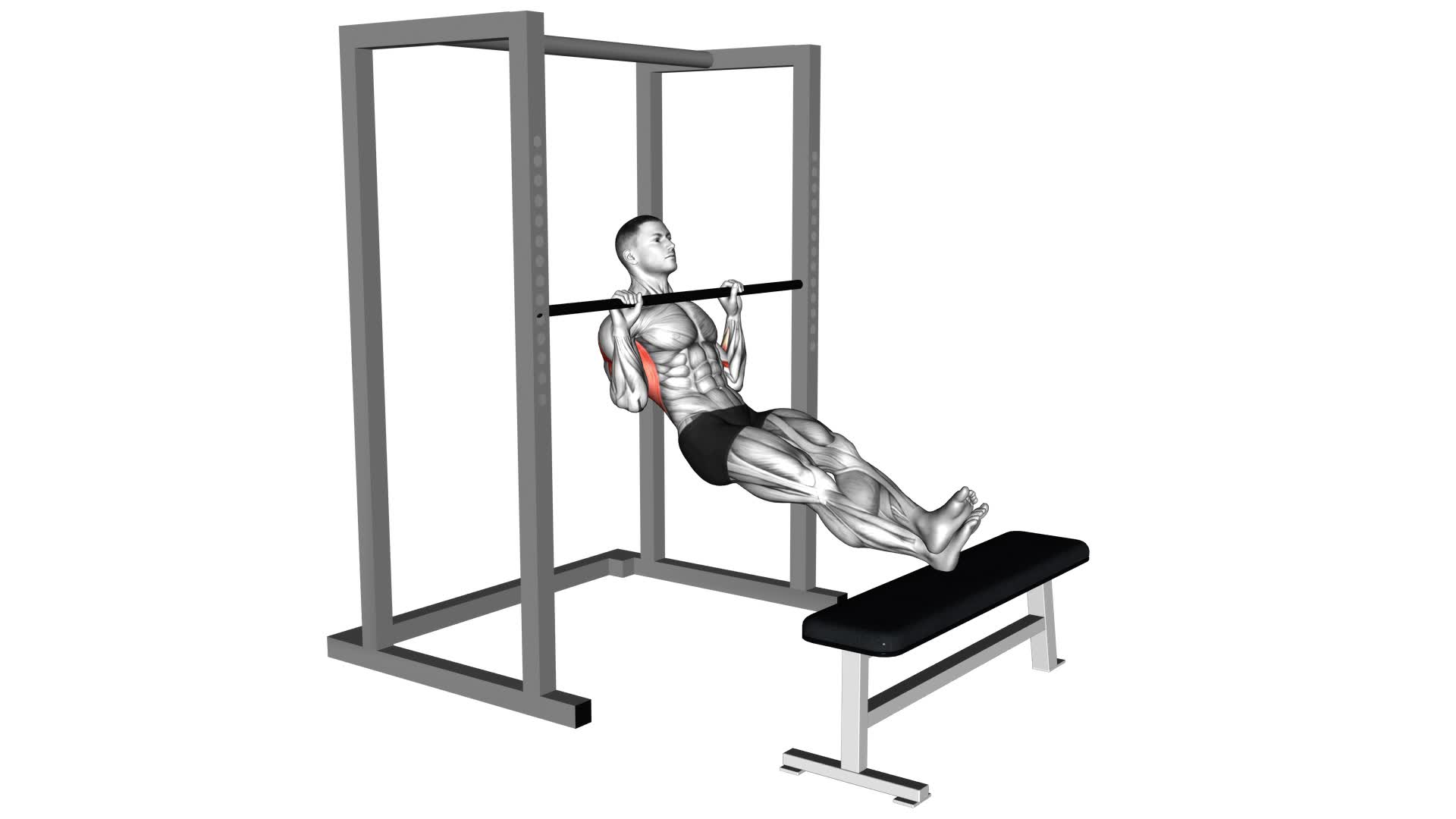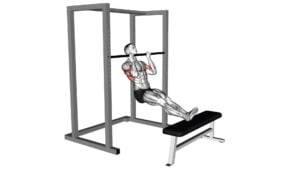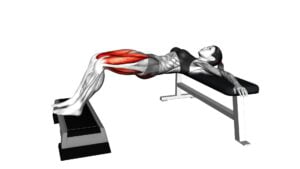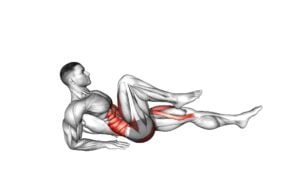Seated Pull-Up (Legs Elevated) – Video Exercise Guide & Tips

Are you looking to take your upper body strength to the next level? The seated pull-up (legs elevated) might be just the exercise for you.
Watch This Exercise Video
In this video exercise guide, you'll learn the proper form and technique to maximize your results.
Whether you're a beginner or an experienced fitness enthusiast, we've got modifications and advanced variations to suit your needs.
Get ready to challenge yourself and get the most out of your workout with these helpful tips.
Let's get started!
Key Takeaways
- Seated Pull-Up (Legs Elevated) increases upper body strength and stability.
- Engaging core muscles and maintaining control is important for proper form and technique.
- Using a sturdy chair or bench with a stable platform is necessary for equipment and set-up.
- Beginners can modify the exercise by using a chair for assistance or reducing the range of motion.
Benefits of the Seated Pull-Up (Legs Elevated)
You will frequently experience increased upper body strength and stability when performing the seated pull-up with elevated legs. This variation of the pull-up exercise adds an extra challenge to your routine by increasing the difficulty level. By raising your legs off the ground, you engage your core muscles to maintain balance and control throughout the movement.
The seated pull-up with elevated legs primarily targets your back muscles, specifically the latissimus dorsi, rhomboids, and trapezius. However, this exercise also activates your biceps, forearms, and shoulders to assist in the pulling motion.
As you pull your body up towards the bar, your back muscles contract, working against gravity to lift your body weight. This muscle activation not only strengthens your back muscles but also improves your posture and overall upper body stability.
Incorporating the seated pull-up with elevated legs into your workout routine can help you build functional strength, which translates into improved performance in daily activities that require upper body strength, such as lifting, pulling, and pushing. Additionally, this exercise can be beneficial for athletes involved in sports that require upper body strength, such as rock climbing, gymnastics, and swimming.
Proper Form and Technique
To ensure proper form and technique for the seated pull-up with elevated legs, focus on engaging your core muscles and maintaining control throughout the movement. This exercise is a great way to target your upper body, specifically your back muscles, while also challenging your core stability.
When performing the seated pull-up with elevated legs, it's important to avoid common mistakes that can compromise your form and limit the effectiveness of the exercise. One common mistake is using momentum to swing your body up, rather than relying on your back muscles to perform the movement. To avoid this, start by sitting upright with your legs extended and raised off the ground. As you pull yourself up, focus on squeezing your shoulder blades together and using your back muscles to lift your body.
To progress with the seated pull-up with elevated legs, you can gradually increase the height of the surface on which your legs are elevated. This will increase the difficulty and challenge your upper body strength even more. Additionally, you can experiment with different grip variations, such as a wide grip or close grip, to target different muscles in your back.
Remember to always maintain proper form and technique throughout the exercise to maximize its benefits and minimize the risk of injury.
Equipment and Set-Up
To properly set up for the seated pull-up with elevated legs, gather a sturdy and stable surface to elevate your legs on. Here's what you'll need and how to set it up:
- Equipment:
- A sturdy chair or bench: Choose a chair or bench that's strong enough to support your body weight. Make sure it doesn't wobble or slide during the exercise.
- A stable platform: You can use a step, yoga block, or even a weight plate to elevate your legs. Ensure it's secure and won't move while you perform the exercise.
- Positioning:
- Place the chair or bench in front of a pull-up bar or a sturdy overhead structure that you can hold onto during the exercise.
- Position the stable platform behind the chair or bench and adjust its height according to your comfort level. It should allow your legs to be elevated without straining your lower back.
- Safety Precautions:
- Clear the area around the chair or bench to prevent any tripping hazards.
- Make sure the pull-up bar or overhead structure is securely mounted and can support your body weight.
- Double-check:
- Before you start, ensure that all equipment is in place and properly set up. Test the stability of the chair or bench, the stability of the platform, and the strength of the pull-up bar or overhead structure.
Modifications for Beginners
If you're a beginner looking to modify the seated pull-up exercise, there are a few options available to you.
First, you can use a chair for assistance by placing it in front of you and using your legs to push off as needed.
Another option is to use a band for support, which can help you build strength and gradually decrease the amount of assistance over time.
Lastly, you can reduce the range of motion by not lowering yourself all the way down, allowing you to still work on the pulling motion without straining yourself.
Chair Assistance Technique
Use a chair to assist you in performing the seated pull-up exercise for beginners. Here are some chair modifications and alternative exercises to help you build strength and progress in your pull-ups:
- Chair Assistance Technique:
Place a chair in front of the pull-up bar. Stand on the chair and grab onto the bar with an overhand grip. Use your legs to assist you as you pull yourself up towards the bar. Gradually decrease the amount of leg assistance as you get stronger.
- Negative Pull-Ups:
Start at the top of the pull-up position with your chin above the bar. Slowly lower yourself down, focusing on the eccentric portion of the exercise. Use a chair to assist you in getting back to the top position.
- Band Assisted Pull-Ups:
Loop a resistance band around the pull-up bar. Place one or both feet in the band to help support your body weight as you pull yourself up.
Band for Support
When using a resistance band for support, you can enhance your seated pull-up exercise, making it more accessible for beginners. By attaching a resistance band to the pull-up bar and looping it around your feet or knees, you create an additional point of support during the exercise. This allows you to reduce the amount of bodyweight you need to lift, making it easier to perform the movement.
The band support provides assistance throughout the entire range of motion, helping you build strength and confidence in the exercise. As you progress and become stronger, you can gradually reduce the assistance provided by the band by using a lighter resistance band or by looping the band in a way that provides less support.
This modification is a great way for beginners to gradually build up their strength and work towards performing a full seated pull-up without assistance.
Reduced Range of Motion
To modify the seated pull-up exercise for beginners and reduce the range of motion, you can adjust the starting position by lowering the pull-up bar. This modification helps beginners build strength and gradually increase their range of motion over time.
Here are some benefits of reducing the range of motion in the seated pull-up exercise:
- Reduced strain: By limiting the range of motion, you decrease the stress on your muscles and joints, making the exercise more manageable for beginners.
- Increased muscle activation: With a reduced range of motion, you can focus on engaging specific muscles, such as the back and biceps, effectively targeting and strengthening those areas.
- Improved form: By starting with a lower pull-up bar, beginners can maintain proper form throughout the exercise, ensuring optimal muscle activation and reducing the risk of injury.
- Gradual progression: As beginners gain strength and confidence, they can gradually increase the range of motion by raising the pull-up bar, challenging themselves further.
Advanced Variations for the Experienced
Challenge yourself with advanced variations of the seated pull-up to further enhance your strength and conditioning. By incorporating advanced modifications and training techniques into your routine, you can take your seated pull-ups to the next level.
One advanced variation to try is the weighted seated pull-up. This involves attaching a weight plate or wearing a weighted vest to increase the resistance and intensity of the exercise.
Another challenging variation is the one-arm seated pull-up. This requires significant upper body strength and stability, as you pull your entire body weight up using only one arm. To further intensify the exercise, you can also add a twist at the top of the movement, engaging your core and obliques.
Lastly, for those seeking an even greater challenge, the plyometric seated pull-up is an explosive variation that incorporates a quick and powerful pull-up followed by releasing your grip and jumping off the seat.
These advanced variations will push your limits and help you achieve new levels of strength and conditioning.
Tips for Getting the Most Out of Your Seated Pull-Up (Legs Elevated) Workout
To get the most out of your seated pull-up (legs elevated) workout, it's important to focus on proper form techniques.
Make sure you maintain a straight back, engage your core, and pull yourself up using your upper body strength.
Additionally, gradually increasing the resistance levels by using a weighted vest or adding weight plates will help to continually challenge your muscles and promote strength and muscle growth.
Proper Form Techniques
Maximize your seated pull-up (legs elevated) workout by focusing on proper form techniques. By following these tips, you can ensure that you're targeting the right muscle groups and avoiding common mistakes:
- Start with proper posture: Sit up straight, engage your core, and keep your shoulders pulled back.
- Grip the bar correctly: Use an overhand grip with your hands slightly wider than shoulder-width apart.
- Initiate the movement with your back muscles: Focus on pulling your shoulder blades down and back as you pull yourself up.
- Control the descent: Lower yourself down in a slow and controlled manner, engaging your back muscles throughout the movement.
By paying attention to these form techniques, you can maximize the effectiveness of your seated pull-up (legs elevated) workout and achieve better results.
Happy exercising!
Increasing Resistance Levels
To increase the resistance levels and optimize your seated pull-up (legs elevated) workout, focus on gradually adding weight to challenge your muscles. This technique, known as progressive overload, is essential for building strength and muscle mass.
Start by using a weight that allows you to perform 8-12 reps with proper form. Once you can easily complete 12 reps, it's time to increase the weight. Aim to add 5-10% more weight each time you progress. This gradual increase will keep your muscles constantly challenged and prevent plateauing.
Additionally, make sure to maintain proper form throughout the exercise, as adding too much weight too quickly can compromise your technique and increase the risk of injury.
Frequently Asked Questions
How Many Calories Can You Burn by Doing Seated Pull-Ups With Elevated Legs?
Seated pull-ups with elevated legs can be a great way to burn calories. By engaging your upper body and core muscles, you can increase your heart rate and boost your calorie burn. While the exact number of calories burned will vary depending on factors like your weight and intensity level, this exercise is generally considered to be a high-intensity movement that can help you torch calories efficiently.
Can Seated Pull-Ups With Elevated Legs Help in Building Muscle Mass?
Seated pull-ups with elevated legs can definitely help in building muscle mass. By incorporating this variation into your workout routine, you engage multiple muscle groups, including your back, biceps, and shoulders. This exercise targets and strengthens these muscles, promoting muscle growth and development.
Additionally, the increased difficulty of having your legs elevated can further enhance the muscle-building benefits. While calorie burn varies depending on factors like intensity and duration, seated pull-ups with elevated legs can contribute to overall calorie expenditure during your workout.
Can Seated Pull-Ups With Elevated Legs Help in Improving Grip Strength?
Seated pull-ups with elevated legs can be beneficial for improving grip strength. By engaging your upper body muscles and focusing on pulling yourself up using your hands, you're putting a significant amount of stress on your grip.
This exercise can help strengthen your fingers, hands, and forearms, ultimately improving your grip strength. Incorporating seated pull-ups with elevated legs into your workout routine can be an effective way to develop a stronger grip.
Are Seated Pull-Ups With Elevated Legs Suitable for People With Lower Back Problems?
If you have lower back problems, seated pull-ups with elevated legs may not be suitable for you. This exercise puts strain on your lower back and could potentially worsen your condition.
Instead, consider modifications such as using assistance bands or performing seated rows to target your back muscles without compromising your lower back.
Always consult with a healthcare professional or certified trainer to find alternatives that are safe and effective for your specific needs.
How Often Should Seated Pull-Ups With Elevated Legs Be Incorporated Into a Workout Routine for Optimal Results?
To achieve optimal results in your workout routine, it's important to incorporate seated pull-ups with elevated legs. The frequency of training will depend on your fitness level and goals.
These pull-ups effectively activate your muscles, especially the back, arms, and core. To progress, you can try different variations such as using different grips or adding weights.
Remember to listen to your body and gradually increase the intensity for better results.
Conclusion
The seated pull-up with elevated legs is a challenging exercise that targets the upper body and core muscles. By elevating the legs, you increase the intensity and engage more muscles. Proper form and technique are crucial to maximize the benefits of this exercise.
Beginners can modify the exercise by using assistance or starting with a lower elevation. Advanced variations can be done by adding weight or increasing the elevation.
Remember to always listen to your body and consult a professional if needed.

Author
Years ago, the spark of my life’s passion ignited in my mind the moment I stepped into the local gym for the first time. The inaugural bead of perspiration, the initial endeavor, the very first surge of endorphins, and a sense of pride that washed over me post-workout marked the beginning of my deep-seated interest in strength sports, fitness, and sports nutrition. This very curiosity blossomed rapidly into a profound fascination, propelling me to earn a Master’s degree in Physical Education from the Academy of Physical Education in Krakow, followed by a Sports Manager diploma from the Jagiellonian University. My journey of growth led me to gain more specialized qualifications, such as being a certified personal trainer with a focus on sports dietetics, a lifeguard, and an instructor for wellness and corrective gymnastics. Theoretical knowledge paired seamlessly with practical experience, reinforcing my belief that the transformation of individuals under my guidance was also a reflection of my personal growth. This belief holds true even today. Each day, I strive to push the boundaries and explore new realms. These realms gently elevate me to greater heights. The unique combination of passion for my field and the continuous quest for growth fuels my drive to break new ground.



